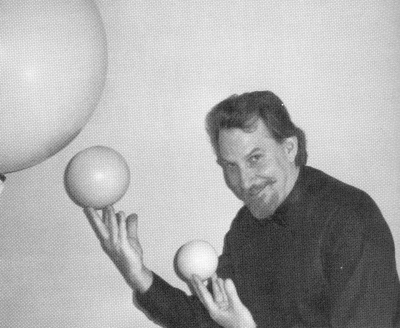
Which stage ball is right for you? The author, Eric Bagai, points out some choices. (Photo by Maria Thomas) |
Page 8 Winter 1996 - 97
|
What's a Stage Ball? by
Eric Bagai
A
four-inch stage ball is about the size and
No,
they don't. Beanbags are designed for the juggler - and only
secondarily for the juggler's audience. Beanbags are perfect for
learning to juggle, but no matter how bright their colors, they
still look like, well, beanbags. Clubs and rings look good in
performance. They are great for showing off a numbers or passing
act. But for three and four ball tricks, stage balls are usually
better. For example, a four club or four ring (or four chicken)
Mills' Mess looks less interesting
"It
is designed to not bounce away from you when you drop it on a
stage." This is the usual explanation of a stage ball. And it's
true, but lame. It makes the ball sound like an inflated beanbag.
And yes, this kind of ball doesn't bounce very much on a stage (or
anywhere else), but that's not a sufficient reason for its name.
A
good stage ball attracts attention. It looks big in the hand, like a
cartoon ball, like a child's idealized conception of a ball: a
perfect sphere, deeply saturated with a single, pure color, with
bright highlights dancing on its surface. It looks as if it belongs
on a spotlighted stage, or in a buskers' circle in the town square
on a sunny afternoon. It looks "circus." It doesn't just
look like a ball, it looks like the ball.
For
the juggler, a good stage ball should have a texture that permits it
to be gripped firmly and positively. At the same time, it should not
cling to other balls held in the same hand. Its weight (regardless
of size) should be about that of a heavier beanbag, so that it
doesn't skitter away, and yet it should be light enough to be
juggled for long periods. And sure, it shouldn't bounce away when
you drop it.
Stage
balls were developed and first brought to the juggling market in the
late 1970s by Brian Dube. Others followed his example and the vinyl
stage ball soon became standard equipment. Dube recently had new
In
1995, Tony Duncan won the IJA Individuals gold
They're
also bigger - and bigger, for many contact moves, is easier. It is for
this reason that Renegade
introduced the 4.5" stage ball. It's only available in an
orange-red, but by golly it is big. (Rumor has it that they'll have a
5.5" ball out real soon now.) Renegade also carries a line of
four-inch stage balls that are slightly softer than Dube's - a bit
like Dube's old ones.
Some
jugglers prefer the 100 mm (almost four-inch) stage ball from Mister
Babache. The reason for this is that they find this ball has a
better grip, especially for contact juggling. It is also much softer
than other stage balls. When it gets dirty, its naturally tacky
surface is easily renewed with a rinse in the drinking fountain -
but this is just as true with all other stage balls. (I've found
that disposable premoistened wipes work nicely too, just as they do
for silicones.)
Beard
produces 75 mm (about three-inch) stage balls with a matte surface
that looks like that of a silicone ball, though of course they don't
feel or bounce like silicone. Beard also make the OX ball, which
looks like a small, shiny stage ball, but handles like a beanbag. I
think both of these innovations are more a reversion to the beanbag
than an extension of the stage ball, but they are very popular.
(Beard also has regular vinyl and ultravioletfluorescent stage
balls.)
Jugglebug,
Klutz, and Infinite Illusions also produce three-inch stage balls,
or rather, like everyone else, have them made to their
specifications by plastics manufacturers. However, their
specifications are generally similar, as are their prices. So go
with your favorite vendor.
At
less than three-inches, what you've got is not so much a stage ball as
a juggling ball that doesn't bounce when you drop it. Of course
numbers jugglers will prefer the smaller balls, but the whole point of
a stage ball is style and show. When Neil Stammer does seven balls in
performance there's a very good reason why he uses four-inch stage
balls rather than smaller balls or beanbags.
Which
stage balls you choose will depend on what you want to use them for,
plus all of those indefinable characteristics that make jugglers
fanatically loyal to one prop manufacturer rather than another. What
I've tried to do here is give you an idea of what characteristics you
might want to look for in a stage ball, and why you might want some in
the first place. Which ones do I use? Don't be silly. I use all of
them! And sometimes I use softballs, too. Stage
ball manufacturers: European
stage balls are available from Beard Juggling Equiment, U.K. Brian Dube, Inc., U.S. Jugglebug (Sport Time),
Klutz, U.S. , Infinite Illusions, U.S.
Mister Babache / ]onglerie
Diffusion, S.A. Renegade Juggling Equipment, U. S. |

Which stage ball is right for you? The author, Eric Bagai, points out some choices. (Photo by Maria Thomas) |